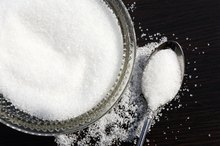How Cheese Affects Glucose in a Diabetes Diet
The higher the glycemic index of the food, the higher you can expect your blood sugar to rise after eating it. Cheese has a very low glycemic index and has minimal impact on blood sugar values in a person with diabetes. It is a great option for a snack and pairs well with carbohydrate-containing foods to blunt their ability to raise blood sugar. Choose low-fat varieties for a healthy option in your diet.
Glycemic Index
Not all foods affect blood sugar in the same way. The glycemic index, or GI, was developed as a method to evaluate how much and how quickly a food will raise blood sugar after consumption. In general, the more refined the food and the higher the carbohydrate content is, the higher the GI will be. Low-GI foods have a ranking of 55 or below, moderate-GI foods have a ranking of 56 through 75 and high-GI foods have a ranking of 76 through 100 and are often refined carbohydrates.
Cheese and Diabetes
Can I Tell What the Glycemic Index Is by Reading a Food Label?
Learn More
Dairy products generally have a low GI and fit well in a diabetic diet. Cheese is similar to foods in the protein group that contain predominantly fat and protein, and it has a lower GI than yogurt or milk. For example, one slice of American cheese has only 1 gram of carbohydrate, causing a very minimal impact on blood sugar. For a healthy snack that has a low GI, registered dietitian Joy Bauer suggests eating part-skim string cheese, which has 80 calories and no grams of carbohydrate. To keep calories and saturated fat low, choose a low-fat version of your favorite cheese.
Combining Foods Affects Glycemic Index
Combining foods will alter the GI. Pair low-GI foods with high-GI foods to create a meal that more moderately affects your blood sugar. Foods with higher proportions of protein and fat will often have minimal impact on blood sugar. For example, adding a low-GI food such as cheese to a slice of bread will result in a lower GI than eating the bread alone. Specifically, a slice of white bread with skim milk cheese has a GI of 55, and a slice of white bread alone has a GI of 71, according to the 2002 International Table of Glycemic Index and Load.
Factors Affecting Blood Sugar Response
Glycemic Index of Cheerios
Learn More
Several factors will affect the GI of a food you're eating. Some of these factors are the physical form of the food, meaning how much processing was involved; the cooking time, because longer cooking times may increase GI such as with pasta; the fiber content -- generally foods with higher soluble fiber are digested more slowly and have a lower GI; and whether the food is combined with other foods. If you have diabetes, it is important to keep your blood sugar levels in good control to reduce the risk of related medical problems such as kidney disease and vision and nerve problems. A low-fat cheese can help you achieve more balanced blood sugar levels if you replace calories from carbohydrates with those from cheese. For instance, use one-quarter less pasta than usual and add low-fat ricotta cheese to a baked pasta dish.
Related Articles
References
Writer Bio
Melanie Di Stante is a registered dietitian and a NCBDE-certified diabetes educator with more than 10 years of experience. She received a bachelor's degree in dietetics from the University of Connecticut and a master's degree in human nutrition from the City University of New York. Di Stante has been writing professionally for more than 10 years, contributing to local newspapers and "Today's Dietitian."









